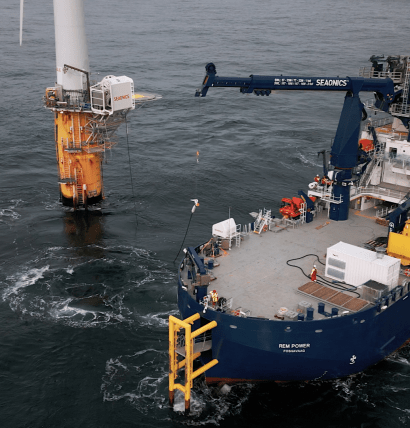
High-voltage charging tests were conducted in port to charge the batteries on the Rem Offshore-owned diesel-electric hybrid CSOV (Construction Service Operation Vessel) REM Power (built 2023) as well offshore from a charging point (cable reel, winch and control system) mounted on a wind turbine.
"At 10 years old, the turbine is one of the smallest offshore but the prototype proved it is possible to install the Ocean Charger on an existing turbine and charge an SOV from day one, using 11 kilovolt (KV) current delivering 6 MW of charge. Apart from a handful of improvement points to fix, the concept and control system are complete and the product is available for sale as is. We're first in the market and already in talks with wind farm owners," said Bjørnar Huse, Sales Manager, Offshore Energy at Seaonics.
He adds that because power current varies between wind parks and wind turbines, the commercial version will have to be customized for each project.
Significance and benefits
The ability to charge vessels offshore in a cost-effective way is a central enabler for shipbuilders to deliver zero-emission SOVs to the offshore wind industry.
"Connecting vessels to the power grid in the wind farm and charging batteries regularly is a big step towards increasing sustainable operations without using any additional energy sources. It saves the time and energy needed to return to port to charge, while the operating cost of electric SOVs versus diesel and alternative fuels is much lower, because both the energy is cheaper and you reduce engine maintenance demands," said Huse.
A large, 60-person SOV consumes 20 to 25 MW hours per day, so at 6 MW you can potentially charge for a full day's operation in three to four hours.
"But it's better for the lifetime of the battery pack to never be completely depleted nor fully charged – between 50 and 80% is best. You could charge for six hours at night, say, then do ad-hoc charging during the day," Huse said.
Meanwhile, wind farm owners are moving away from the idea of locating charging points on a substation or expensive floating buoys.
"The standard will most likely be to locate the charging point on a turbine. Downscaling the weight and cost also means you can have many charging points reducing the need to cruise long distances to charge," Huse added.
Standardized solution
The Ocean Charger's standardized solution is cost effective because it uses an industry-standard connector plug and power levels both for offshore charging and in port.
"The prototype worked using a standard vessel and crane. The plug is an industry standard used for shore charging cruise ships as well as Hoegh Autoliners' Aurora-class hybrid-electric newbuild car carriers. Tying known technology together made it easier to get to a prototype in a relatively short time. We didn't have to invent a lot of new components unlike some competitors using a bespoke plug," Huse said.
The product can be fitted to any structure and vessel and the power integrated with the vessel switchboard and the chosen charging voltage.
The current issue
Discussions are currently underway with wind park owners regarding charging current. Wind parks usually have 66 or 132 KV requiring one or two transformers – one on the charging point and another on the vessel – to get the high voltage down to medium or low voltage.
"Some have asked us to explore bringing 132 KV, which is the standard current in big power lines on land, directly onto the vessel and do all the transformation onboard. However, managing such high current would require a very bespoke handling and safety system. Feasibility depends on the cost of power integration and transformers," said Huse.
"The cost-effective compromise is to stick with 11 KV, which is what the Aurora-class vessels use but is still high considering the standard shore connection for fishing vessels and small SOVs today is typically 690 or 1,000 volts, using the same equipment for both offshore and shore charging."
Time for tailoring
Huse says it would take a few months to customize the configuration and get approvals for a specific wind park and vessel.
"For wind farms that will be installed in two to four years' time, there is ample time to do final integration design, fabrication and installation on a new chartered SOV or retrofit an existing one. Fitting the charging points to turbines before they are installed also streamlines the operation."

